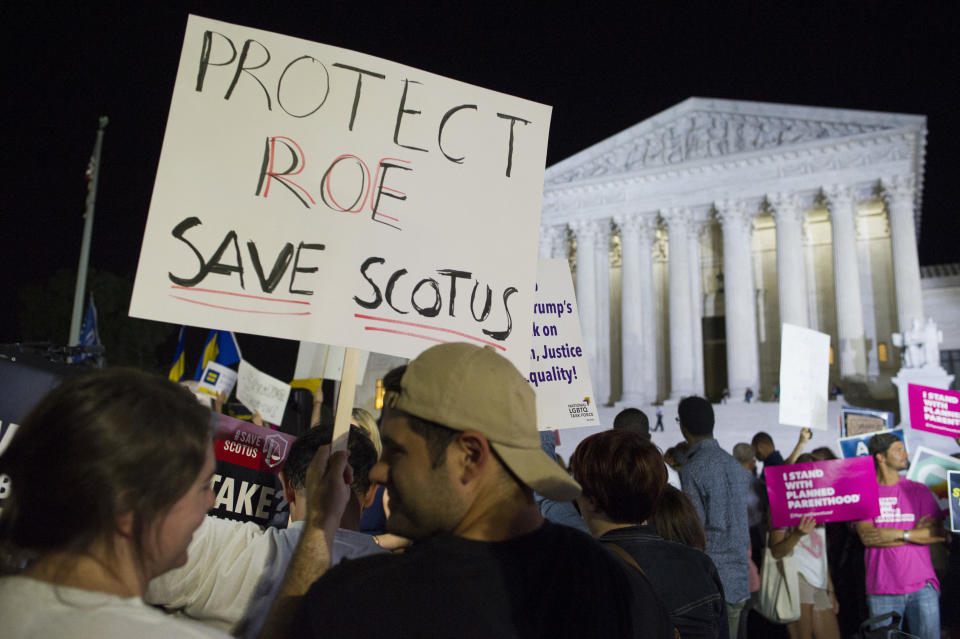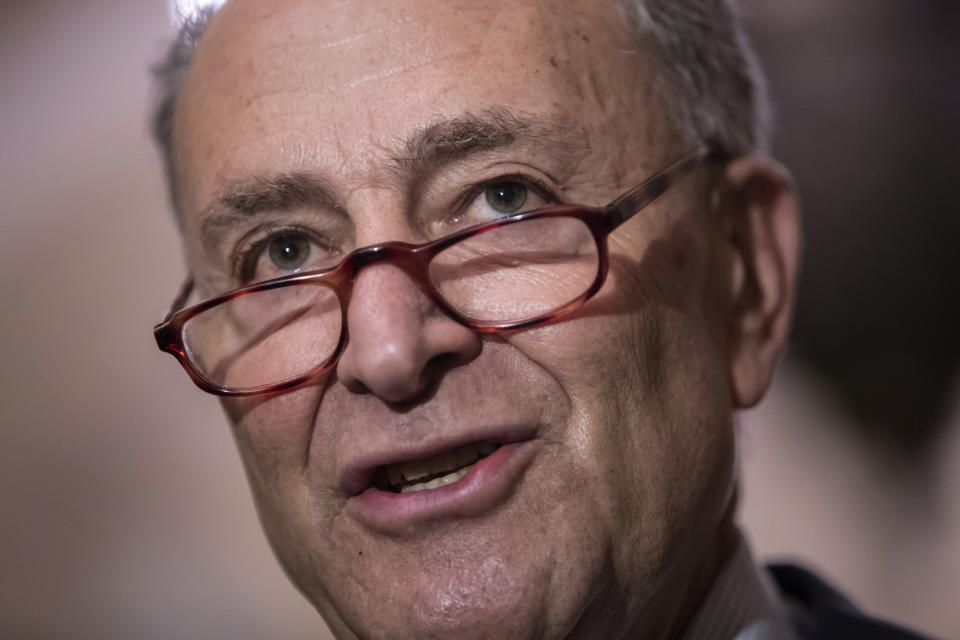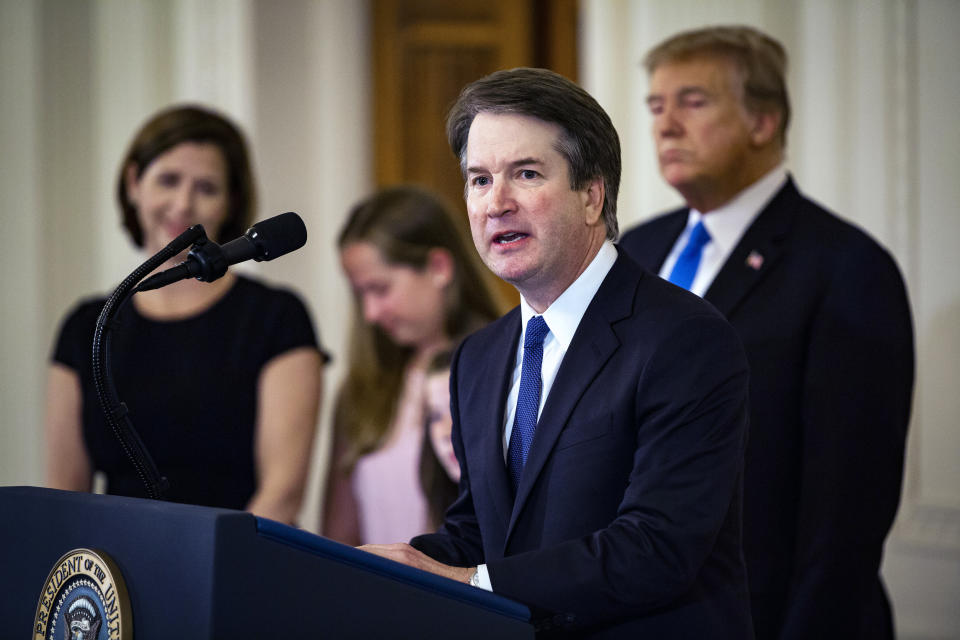Democrats vow fight of a lifetime to keep Brett Kavanaugh off Supreme Court
WASHINGTON — “Hell no, Kavanaugh,” erupted the shouts outside the U.S. Supreme Court shortly after the primetime revelation that President Trump had nominated Judge Brett Kavanaugh, 53, of the U.S. Court of Appeals for the District of Columbia Circuit, to the nation’s highest court. As night deepened, the crowd grew — and grew louder. The vast majority of those gathered on First Street, in sight of the Capitol’s glittering dome, were firmly in the anti-Trump camp, as evidenced by their signs: “What’s at Stake? LGBTQ Rights, Roe v. Wade, Health Care”; “Stop Trump’s Supreme Court Takeover”; “I Stand With Planned Parenthood.” And though the nomination wasn’t yet an hour old, “Stop Kavanaugh” signs also flourished.
There is little reason to expect such passion to subside anytime soon. In fact, Democrats both on and off Capitol Hill have been plotting a multipronged strategy to accomplish what most experts have said would be impossible for a minority party in a post-filibuster age. They hope to #StopKavanaugh, as one of the movement’s newly minted hashtags would have it — and #SaveSCOTUS from shifting decisively rightward for a generation or more in the process.
“I think this will be an enormous fight, and it should be,” Senate expert Ira Shapiro told Yahoo News. In a conversation shortly before the announcement of Trump’s nomination, Shapiro, author of The Last Great Senate, said he was skeptical about any “procedural obstruction” Senate Minority Leader Chuck Schumer, D-NY, might attempt. “I think that Sen. McConnell would change every rule of the Senate if necessary to ensure that the nomination is voted upon,” Shapiro said, referring to Senate Majority Leader Mitch McConnell, R-Ky. “Ultimately, the only way to defeat this nomination is by making the most comprehensive case about the constitutional rights that are at stake and the future of the court for the next 30 years.”
Senate Democrats no longer have the option to torpedo Kavanaugh outright, thanks to the GOP’s controversial 2017 decision to lower the longstanding 60-vote threshold for Supreme Court nominees to a simple majority. Because Democrats currently control only 49 Senate seats, they can’t just band together and block Trump’s pick.
Even so, they do have options — and they intend to use them. In the days and weeks ahead, there will be nationwide grassroots organizing. There will be complex parliamentary maneuvering. There will be raw political pressure applied to a handful of senators — two pro-choice Republicans and three red-state Democrats — who could make or break Kavanaugh’s nomination. And there will be tens of millions of dollars spent on the battle.
“Progressives are very mobilized over the Supreme Court in a way that I haven’t seen for a long time,” Neera Tanden of the liberal Center for American Progress told Yahoo News on Tuesday evening. Tanden said the “kabuki theater” that has been the recent confirmation process, in which nominees are allowed to reveal little of their actual judicial philosophy, must end. And she called on two moderate Republican women, Sen. Susan Collins of Maine and Sen. Lisa Murkowski of Alaska, to stand by their support for abortion rights, which some believe are under threat with an increasingly conservative Supreme Court. “Activists and advocates have to hold their feet to the fire,” Tanden said, wondering if the two would want to be responsible, however indirectly, for having overturned the Roe v. Wade decision, which legalized abortion.

Much as with the battle over the Affordable Care Act, liberals appear to be energized by the seemingly intractable odds against them. They won that fight, and they believe they can win this one too. Their strategy will be to represent Kavanaugh as a dire threat to civil liberties — and a friend to corporations, religious conservatives and gun activists. “Kavanaugh has consistently ruled for the wealthy and powerful over the rights of workers, consumers and women seeking access to health care,” said Vanita Gupta, the former head of the civil rights division of the Department of Justice. Gupta, who currently leads the Leadership Conference, which advocates for a liberal judiciary, called Kavanaugh “a direct threat to our civil and human rights” and “unfit to serve on our nation’s highest court.”
At the very least, the coming weeks will produce one of the fiercest Supreme Court fights in U.S. history. And if Democrats somehow succeed in sinking Kavanaugh — or even delaying his confirmation vote until after November’s midterm election, in which they could regain control of the Senate — #StopKavanaugh may become the most consequential act of anti-Trump resistance to date.
Certainly, congressional Democrats are far more energized than they were in 2017, when Trump nominated Neil Gorsuch to the Supreme Court. “We are in the fight of our lives,” said Sen. Elizabeth Warren, Democrat of Massachusetts, at the rally outside the Supreme Court. Like the other speakers, she was sometimes drowned out by the raucous crowd, which included at least one anti-abortion activist with a loudspeaker or megaphone. He was, for the most part, drowned out himself.
The particulars of that fight remain unclear, but one way or another, Democrats will need 51 votes in the Senate. They will only muster those votes if they can keep their own caucus together, which will involve making sure that Senators from states Trump won — in particular, Heidi Heitkamp of North Dakota, Joe Manchin of West Virginia and Joe Donnelly of Indiana — don’t decide that Kavanaugh is a palatable nominee. To ensure that, Democrats and the liberal base will do everything they can to paint Kavanaugh as an extremist activist who would curb the rights of women and organized labor, while potentially protecting Trump from a possible indictment by special counsel Robert Mueller, who is investigating ties between the Trump campaign and Russia. They will then have to hope to persuade Murkowski and Collins to join them in opposing Kavanaugh. They can also try to wait until the November midterms, though Democrats’ chances of regaining the Senate are not seen as especially good.
Tuesday evening saw liberal groups beginning to organize their opposition to Kavanaugh. “We can’t stop a vote. If McConnell gets the number that he needs, if he gets 51 votes, he will have it and he will confirm a Trump pick,” Angel Padilla, policy director at Indivisible, told Yahoo News. “So, the only thing that we can do in the short term is stop Republicans from getting 51 votes, so that’s what we’re focusing on.”
Minutes after the president’s announcement, stopkavanaugh.com launched, a project by Demand Justice, a progressive organization founded earlier this year. The website highlights Kavanaugh’s views on presidential indictment, the Affordable Care Act and Roe.

The American Civil Liberties Union made a six-figure ad buy that ran Friday through Monday, and specifically called on Collins and Murkowski to ask the nominee to take a clear position on Roe. “We see the path towards [protecting Roe] goes straight through Lisa Murkowski and Susan Collins,” Faiz Shakir, national policy director for the ACLU, told Yahoo News. “I think they hold a lot of power and sway over this particular debate. Everything from whether this nominee is able to get through to how the nominee’s confirmation process will proceed.”
Demand Justice spent $5 million on ads that ran in Maine and Alaska, and it plans to launch more in North Dakota, West Virginia and Indiana, the home states of Democratic Sens. Heitkamp, Manchin and Donnelly. The trio voted to confirm Gorsuch last year. It will fall to Minority Leader Schumer to keep them in line, while buying activists precious time to make the case to Collins and Murkowski.
“Now is the time for hardball, and Sen. Chuck Schumer is up at bat,” Ezra Levin, co-executive director of Indivisible, said in a statement. “As Senate Minority Leader, it’s his job to keep the Democratic Caucus together.”
Prior to Trump’s announcement, Schumer repeatedly argued that whomever the president chose would be unacceptable to Democrats because he or she would “gravely” threaten two existing rights that poll well with a majority of Americans: the right to health care coverage for people with preexisting conditions (as established in the Affordable Care Act) and the right of women to get abortions (as established in the Supreme Court’s 1973 Roe v. Wade decision).
As soon as Trump announced Kavanaugh, Schumer and other Senate Democrats pounced, insisting that the pick had confirmed their worst fears — and only strengthened their resolve to extract real answers from him.
“[Judge Kavanaugh’s] own writings make clear that he would rule against reproductive rights and freedoms, and that he would welcome challenges to the constitutionality of the Affordable Care Act,” Schumer said in a statement. “I will oppose Judge Kavanaugh’s nomination with everything I have.”
To that end, Senate Democrats hope to pin down Kavanaugh on abortion and Obamacare during his confirmation hearings, then use whatever he reveals to pressure one of the Republicans to vote against him. Assuming that ailing Arizona Sen. John McCain retains his seat yet remains in Arizona on extended medical leave, a single GOP defection would produce a 50-49 victory for Democrats, and Kavanaugh would return to the DC Circuit Court.
But that could prove a complicated strategy. Ever since the failed Supreme Court nomination of outspoken conservative Robert Bork in 1987, Supreme Court nominees have proved exceptionally skilled at avoiding anything approaching an honest accounting of their beliefs. Neither Collins nor Murkowski has voted against one of Trump’s judicial appointees.
Immediately after Justice Kennedy announced his retirement, many top Democrats said the Senate should follow the standard set by McConnell in 2016, when he blocked what would prove Barack Obama’s third and final Supreme Court pick, Merrick Garland, and deny a vote to Trump’s next nominee until after the upcoming election. McConnell has dismissed their demand. But Democrats do have some tools at their disposal.
Shapiro, the Senate expert, acknowledged that Garland’s failed nomination was a “searing experience,” but he cautioned against making it the centerpiece of the resistance to Kavanaugh’s nomination. “What matters now is the constitutional rights of Americans,” he said, seeming to suggest that Kavanaugh would be willing to abrogate those rights.
Supreme Court confirmations typically take about two months from nomination to confirmation, and the McConnell-led Republicans are eager to seat Kavanaugh on the court by the time its next session begins Oct. 1. In August, Kavanaugh will head to the Senate Judiciary Committee for hearings, the first step in the confirmation process. Democrats on the committee can gum up the works in several ways, according to Sarah Binder, a senior fellow in Governance Studies at the Brookings Institution and professor of political science at George Washington University, where she specializes in Congress and legislative politics.

“That’s the first real venue where minority party members have opportunity to make themselves difficult,” Binder said.
For instance: The committee’s ultimate job is to issue a recommendation report on Kavanaugh to the rest of the Senate. But to conduct hearings or vote on such a report, a quorum must be present — and a quorum “for the purpose of transacting business” consists of “nine Members of the Committee, including at least two Members of the minority,” according to the committee’s rules of procedure. If eight of the Democrats on the committee refuse to show up, its “business” could conceivably grind to a halt — at least until Republicans figure out how to suspend the rules.
Similarly, another Judiciary Committee rule states that a single member can object to bringing a “matter to a vote without further debate” and that this objection can be upheld if all minority party members vote in its favor. In theory, Binder said, this means that each of the 10 Democrats on the committee could, in turn, register an objection to voting on Kavanaugh’s recommendation report, “round-robin-style” — and that each successive objection could delay the vote for “up to a week.”
In recent days, McConnell urged Trump not to select Kavanaugh for this very reason, according to the New York Times. Concerned about “millions of pages” of documents that Kavanaugh has created in his 12 years on the D.C. Circuit bench — as well as in his roles as White House staff secretary under President George W. Bush and assistant to Kenneth W. Starr, the independent counsel who investigated President Bill Clinton — McConnell reportedly fears that Senate Democrats will now have an opportunity to delay until October or beyond as they demand more time to scour his paper trail.
At some point, however, Binder believes that fed-up Republicans would put in motion a discharge petition, which would bypass the Judiciary Committee and simply bring Kavanaugh’s nomination it to the full Senate for consideration.
“Ultimately, it’s really hard to see minority committee members blocking a vote and delaying forever,” Binder said. “Republicans are very good at playing hardball. Democrats are less good at it.”

Once Kavanaugh is out of committee, Democrats’ options for postponing a vote will ?diminish. Some have discussed the possibility of the 49 Democrats “breaking” quorum in the Senate as a whole by refusing to come to the chamber or vote on anything, thereby making it difficult for Republicans alone to muster the 51 Senators necessary to conduct business. Unfortunately for Democrats, there “are classic responses to quorum-breaking that enable a determined majority to overcome the tactic,” according to University of Miami political scientist Gregory Koger, a specialist in filibustering and legislative obstructionism. In short, any delay from quorum-breaking wouldn’t last long.
Democrats’ final option, said Binder, would be to “take hostages.” By that she means they could pledge to “withhold consent” on the nomination itself or, if forced to vote, on future Republican priorities. The Senate usually operates under “unanimous consent agreements” between the majority and minority parties that speed business along. But any one senator can object to these agreements and slow things to a crawl.
The immediate problem, though, is that withholding consent can’t halt Senate business indefinitely; it typically works for just a few days — a week at most. So the idea that McConnell & Co. would be deterred by such maneuvering is highly improbable — as is the idea that Democrats could sustain any of these blockades until after the midterms and perhaps even until a new Senate is seated in January.
At the same time, there’s a bigger problem to consider: The more extreme the procedural maneuver, the more political risk it entails. Manchin, Heitkamp and Donnelly — and the other seven Democratic incumbents up for reelection in states Trump won — might agree to stick with their fellow Dems and vote against Kavanaugh, reasoning that they’d rather lose a few Trump voters back home in November than discourage the Democratic base. But they’re much less likely to support, say, shutting down the entire government over his nomination.
The ideal situation for Kavanaugh’s opponents would involve the activism of ordinary Americans to merge with whatever parliamentary tactics Democrats hope to use to either stall or kill the nomination. As such, the rally outside the Supreme Court on Monday night suggested that passions, and convictions were at a high point. At the same time, Republicans are clearly confident about their own prospects.
“We are in this fight together,” said Richard Blumenthal, Democrat of Connecticut, implying that the oft-warring factions of the liberal establishment are ready to unite in trying to stop Kavanaugh’s ascension to the Supreme Court.
Whether that unity makes the necessary difference remains to be seen. Across the street from the Supreme Court, in front of the U.S. Capitol, a Yahoo News reporter encountered Sen. Lindsey Graham, Republican of South Carolina, who was in the midst of having his photograph taken. Asked about Kavanaugh’s chances for confirmation, Graham answered quickly, and confidently: “One hundred percent.”
Correction: An earlier version of this story incorrectly stated that Republicans need 51 votes, rather than a simple majority of senators present, to confirm Kavanaugh.
_____
More Yahoo News stories on the Supreme Court:

